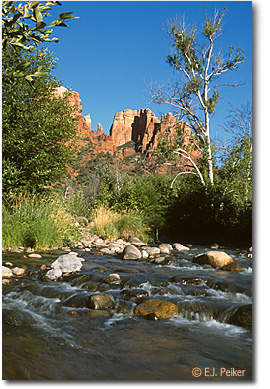
|

EOS 1v versus Oak Creek
Text Copyright and Photography Copyright E.J. Peiker
All rights reserved.
 You've read the hype; the Canon EOS 1v is water resistant, allowing you shoot in the rain. Some magazines (but not Canon) have even hyped it as being submersible for a brief moment. My experience with the 1v and the new L-series lenses with water resistant gaskets has been very good while shooting in driving rainstorms in both Florida and Ohio, without a failure or even the slightest glitch. Unfortunately, I recently had the "opportunity" of discovering how water-proof this excellent camera really is.
You've read the hype; the Canon EOS 1v is water resistant, allowing you shoot in the rain. Some magazines (but not Canon) have even hyped it as being submersible for a brief moment. My experience with the 1v and the new L-series lenses with water resistant gaskets has been very good while shooting in driving rainstorms in both Florida and Ohio, without a failure or even the slightest glitch. Unfortunately, I recently had the "opportunity" of discovering how water-proof this excellent camera really is.
While trying to photograph Cathedral Rock near Sedona, AZ with the Oak Creek running heavily in front of it, I decided that a photograph with the water running off the bottom of the frame, directly below a small waterfall with this beautiful rock formation behind it in golden evening light would be worth the effort. I took off my shoes and waded into the Oak Creek with my Gitzo CF tripod, Kirk BH-1 Ballhead and an EOS1v HS and EF 28-70/f2.8L lens attached. The rocks were so slippery that I did not have enough friction between my feet and the rocks to overcome the current and I got swept away. Myself, the camera with lens, and tripod got fully submerged for about 5 seconds. It seemed like a half hour to me while I was floating down the river with gear in hand. Fortunately I was not hurt in any way other than being very cold for an hour or two.
Once I worked my way out of the water, gear in hand, it was time to assess the damage. The first thing I noticed was that the power to the camera was on. Being an Electrical Engineer by education, I knew this was much worse than it would have been had the power been off - in that case a good drying and clean-up would probably revive the camera - with the power on, all bets were off.
What follows is a chronology of the events starting from the time I got out of the water:
17:00 Hours, Day 1 - Time since dunking - 0 Hours
- The lens is toast! There is water sloshing around inside the lens between the optical elements.
- The camera initially seemed OK. The first sign of failure was that it would not power off. So I popped off the battery, power drive, and the lens and allowed the drying process to start.
- There was no sign that water got beyond the lens mount. No moisture was found on the mirror or in the visible light path.
- There did not appear to be any damage to the power drive.
- Almost immediately, heavy condensation began to form under the camera's LCD panel.
- I was very worried that the film would be damaged since there was no way to rewind the film and no way for me to tell whether water had breached the film compartment. This roll of film had some shots of a beautiful Summer Tanager couple on it that I definitely did not want to lose.
19:00 Hours, Day 1 - Time since dunking - 2 Hours
- I have been driving home for the last two hours with the cars A/C blowing into the camera at the lens mount to dry out the internals by blowing very dry air in and hoping that the water will be carried off by the air absorbing the moisture and thereby removing it from the innards of the camera - the same way a front window defroster works in a car.
- My drying regiment is very successful as the condensation under the LCD has completely disappeared and all of the camera's internals look very dry.
- I reinsert the battery and immediately, without turning on the power, the shutter curtain starts tripping at a high rate of speed. At this point I know there is significant damage to the power distribution system inside the camera and no further power should be applied for fear of causing even more damage.
 01:00 Hours, Day 2 - Time since dunking - 6 hours
01:00 Hours, Day 2 - Time since dunking - 6 hours
- I am back home - time to rescue the film. I put the camera inside black gym bag and zip it up so that only my wrists can get into the bag and go into a pitch black closet at night with the lights off and doors closed in the adjoining room. I open the camera housing and to my delight I feel no trace of moisture. I hand rewind the film in this pitch-black environment so that I can take it to the lab the next morning.
- I place the camera body and lens into a desiccant box for the night to insure further drying.
08:00 Hours, Day 2 - Time since dunking - 13 hours
- Another 7 hours of drying while I sleep. I couldn't resist so I tried to power the camera on again. The camera powers up fine without the rapid shutter curtain movement seen the night before, but there is no Auto Focus, the exposure compensation dial does not work and the camera will not shut-off without removing the battery.
- Its time to take the film to the lab and the camera to the local Canon repair center in Tempe, AZ.
09:00 Hours, Day 2 - Time since dunking - 15 hours
- I submit the camera body and lens to the repair facility and am told by the person that takes in the repairs that they will look at it in about 2 weeks and get back to me. I kindly tell the person that two weeks from now, this whole camera and lens might be a bucket of rust and that it really needs to be taken apart today. She says that she is sorry but that they are backlogged. I ask to talk to the senior Canon technician. He comes out and immediately understands my plight and promises to get started on it immediately.
- Here is the verbiage on the work orders:
- Lens - Completely submerged in water, will not AF, foggy, is this repairable?
- Camera - Completely submerged in water for 5 sec, power not working properly, rear dial, not functional, is this repairable? Gets error display when turned on, won't communicate with lenses.
13:00 Hours, Day 2 - Time since dunking - 19 hours
- I get a call from the technician:
- The lens is repairable. It needs all optics cleaned and possibly a new USM motor but that is not clear at this point.
- The camera is questionable. The patient is in critical condition and on life support. The odds of survival are not good. He will call back later after a more thorough assessment, parts and labor may be more than a new body.
- Fortunately the Power grip and NiMH battery are fine so if I do have to get a new body, I don't need to get the more expensive HS model since I can use the power grip from the old one to make it into an HS model.
17:00 Hours, Day 2 - Time since dunking - 24 hours
- I talked to the Canon tech again. The prognosis on the lens remains very good. The optics have been thoroughly cleaned. He will leave the lens apart over the weekend in a desiccator to thoroughly dry everything and then reassemble. The Tech thinks the USM motor will come back to life as it was drenched when he opened it.
- The camera is still on life support but shows signs of life. The top-end (optical path, shutter, film compartment) was not compromised in any way. The bottom end (power distribution, camera logic, and general electronics) show signs of early corrosion and burnt out contacts due to the camera going into the drink while under power. He is a little more optimistic that cleaning all corrosion and contacts would revive the camera but he had not yet started to dig into why the thumbwheel on the back was not functioning or why no lens would auto-focus. The camera is completely apart and is also desiccating over the weekend.
Day 5 - Time since dunking - approximately 96 hours
- There is an interesting development! It appears my camera body requires a new wrap-around power distribution flex board in the bottom of the camera. However, Canon does not authorize their service centers, including those that are Professional Services accredited, to replace any electronic components on a camera that has been water damaged. The company position is that this requires replacement of the camera. The technician is going to try to repair the board.
- The lens has not been reassembled.
Day 8
- All components of the camera have been cleaned, repaired and tested individually and everything is working as discreet components. The camera is now in queue for reassembly.
- The lens is also in queue for reassembly.
Day 10
- I receive the dreaded call. After assembly there are still power distribution problems indicating damage to the circuit boards and the body will still not power a USM lens motor. At this point I have to buy a new body since I am leaving for Florida on my St. Augustine Alligator Farm excursion to photograph herons and egrets in just three days, and going with just one camera body is too risky for me. I order a new EOS 1v, which arrives the night before I leave. I attach the dunked power drive. It works perfectly and some exposure tests are performed to make sure I know how the meter will behave. Fortunately it matches my other camera body in every respect.
- My first EOS 1v body is a complete write-off at this point. I still have my second body plus the new one I had to purchase.
- The lens has been reassembled, calibrated, tested and is in "as good as new" condition. Final cost of repair - $195.00. Here is the verbiage from service slip: Rush disassembly to dry out parts, repaired water damage, cleaned, lubed and calibrated. 6 mo. Complete warranty.
4 weeks later

- Out of the blue I get a call from the technician that I had been working with. He said that after his clean-up job there was no sign of water damage so he decided to send it back to the factory. There, they replaced all of the electronics, updated the firmware, completely calibrated everything and the camera is like new and working perfectly. Then I asked him the question that I was afraid to hear the answer to: How much will it cost me to get the body back? I had the option of not accepting it since I was told it was a write-off. His answer was "they repaired it under warranty, all I ask is that you pay the $45 shipping"
- One hour later, I had my original EOS 1v body back, fully recalibrated, firmware upgraded to the very latest version, and in perfect working order. Here is the verbiage from this service slip: Rush disassembly to dry out parts, repaired water damage, repaired electronic contacts, replaced main EPU, cleaned, tested and adjusted as needed. Factory Repair Under Warranty/No Charge.
There are obviously several lessons to be learned from this ordeal. First and foremost, taking more care when entering a body of water with expensive electronic equipment is something I will be doing. Second, even though the ultimate cost of the repairs were low, had I had insurance on the equipment, the $1500 I spent on another camera body could have been reduced or eliminated depending on the policy. Third, despite strong temptation, I probably should not have tried to power-up the camera after this occurred although there is no evidence that this caused additional damage. Finally, Canon really does care about its customers and went out of its way to fix my camera and lens. They could have easily given up after the open-heart surgery on the camera body was unsuccessful.
So how water-proof is the EOS 1v? As you can see from the photos here, the EOS 1v is at least partially water proof as no water ever got to the film or into the light path. The photos included in this article were on the roll of film that went under water. The electronics on the other hand, while well insulated from rain, are not well enough insulated to stand a dunking. To the best of our determination, the water entered the camera at the point were the power winder engages the take-up reel on the bottom of the camera body - this is a place that would not be exposed to rain but certainly is vulnerable when the camera is completely submerged.
EJP-NPN 016
Comments on this article? Send them to the editor.


|


 You've read the hype; the Canon EOS 1v is water resistant, allowing you shoot in the rain. Some magazines (but not Canon) have even hyped it as being submersible for a brief moment. My experience with the 1v and the new L-series lenses with water resistant gaskets has been very good while shooting in driving rainstorms in both Florida and Ohio, without a failure or even the slightest glitch. Unfortunately, I recently had the "opportunity" of discovering how water-proof this excellent camera really is.
You've read the hype; the Canon EOS 1v is water resistant, allowing you shoot in the rain. Some magazines (but not Canon) have even hyped it as being submersible for a brief moment. My experience with the 1v and the new L-series lenses with water resistant gaskets has been very good while shooting in driving rainstorms in both Florida and Ohio, without a failure or even the slightest glitch. Unfortunately, I recently had the "opportunity" of discovering how water-proof this excellent camera really is. 01:00 Hours, Day 2 - Time since dunking - 6 hours
01:00 Hours, Day 2 - Time since dunking - 6 hours